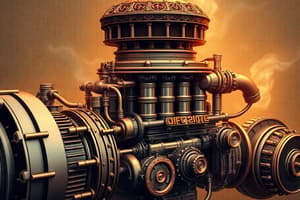Podcast
Questions and Answers
What is the primary function of the crankshaft in an engine?
What is the primary function of the crankshaft in an engine?
- To convert reciprocal motion of pistons into rotary motion (correct)
- To increase compression ratio
- To generate horsepower
- To mix air and fuel
What type of engine uses compression ignition?
What type of engine uses compression ignition?
- Diesel engine (correct)
- Hybrid engine
- Hydrogen engine
- Gasoline engine
What is the purpose of the clutch in a manual transmission?
What is the purpose of the clutch in a manual transmission?
- To provide infinite gear ratios
- To disconnect engine from transmission during gear shifts (correct)
- To shift gears automatically
- To engage the torque converter
What is the benefit of using an All-Wheel Drive (AWD) transmission system?
What is the benefit of using an All-Wheel Drive (AWD) transmission system?
What is the primary function of brake pads in a braking system?
What is the primary function of brake pads in a braking system?
What is the purpose of the Anti-Lock Braking System (ABS)?
What is the purpose of the Anti-Lock Braking System (ABS)?
What is the relationship between displacement and power output in an engine?
What is the relationship between displacement and power output in an engine?
What is the primary function of the pistons in an engine?
What is the primary function of the pistons in an engine?
What is the purpose of the gearsets in a transmission system?
What is the purpose of the gearsets in a transmission system?
What is the primary function of the rotors in a disc brake system?
What is the primary function of the rotors in a disc brake system?
Flashcards are hidden until you start studying
Study Notes
Engine Performance
- Horsepower and Torque: Horsepower measures an engine's power output, while torque measures its rotational force.
- Engine Types:
- Gasoline Engines: Most common type, using spark ignition and air-fuel mixture.
- Diesel Engines: Use compression ignition, more efficient but heavier.
- Hybrid Engines: Combine conventional engine with electric motor for improved efficiency.
- Engine Components:
- Cylinders: Where combustion takes place, typically 4, 6, or 8 in modern engines.
- Pistons: Move up and down in cylinders, driven by explosive force.
- Crankshaft: Converts reciprocal motion of pistons into rotary motion.
- Engine Performance Metrics:
- Compression Ratio: Affects engine efficiency and power output.
- Displacement: Total volume of all cylinders, affects power output.
Transmission Systems
- Manual Transmission: Driver manually shifts gears using clutch and gearshift.
- Automatic Transmission: Uses torque converter and planetary gearset to shift gears automatically.
- Continuously Variable Transmission (CVT): Uses belts and pulleys to provide infinite gear ratios.
- Transmission Types:
- Front-Wheel Drive (FWD): Power sent to front wheels.
- Rear-Wheel Drive (RWD): Power sent to rear wheels.
- All-Wheel Drive (AWD): Power sent to all four wheels.
- Transmission Components:
- Clutch: Disconnects engine from transmission during gear shifts.
- Gearsets: Provide different gear ratios for varying driving conditions.
Brakes
- Brake Types:
- Disc Brakes: Use caliper to squeeze brake pads against rotor.
- Drum Brakes: Use shoes to press against brake drum.
- Brake Components:
- Brake Pads: Wear out over time, need regular replacement.
- Rotors: Wear out over time, need regular resurfacing or replacement.
- Braking Systems:
- Anti-Lock Braking System (ABS): Prevents wheel lockup during hard braking.
- Electronic Stability Control (ESC): Helps stabilize vehicle during sharp turns or slippery conditions.
Engine Performance
- Horsepower measures an engine's power output, while torque measures its rotational force.
- Gasoline engines are the most common type, using spark ignition and air-fuel mixture.
- Diesel engines use compression ignition, are more efficient but heavier.
- Hybrid engines combine conventional engine with electric motor for improved efficiency.
- Cylinders are where combustion takes place, typically 4, 6, or 8 in modern engines.
- Pistons move up and down in cylinders, driven by explosive force.
- The crankshaft converts reciprocal motion of pistons into rotary motion.
- Compression ratio affects engine efficiency and power output.
- Displacement is the total volume of all cylinders, affecting power output.
Transmission Systems
- Manual transmission requires the driver to manually shift gears using clutch and gearshift.
- Automatic transmission uses torque converter and planetary gearset to shift gears automatically.
- Continuously Variable Transmission (CVT) uses belts and pulleys to provide infinite gear ratios.
- Front-Wheel Drive (FWD) sends power to front wheels.
- Rear-Wheel Drive (RWD) sends power to rear wheels.
- All-Wheel Drive (AWD) sends power to all four wheels.
- The clutch disconnects engine from transmission during gear shifts.
- Gearsets provide different gear ratios for varying driving conditions.
Brakes
- Disc brakes use a caliper to squeeze brake pads against the rotor.
- Drum brakes use shoes to press against the brake drum.
- Brake pads wear out over time and need regular replacement.
- Rotors wear out over time and need regular resurfacing or replacement.
- Anti-Lock Braking System (ABS) prevents wheel lockup during hard braking.
- Electronic Stability Control (ESC) helps stabilize the vehicle during sharp turns or slippery conditions.
Studying That Suits You
Use AI to generate personalized quizzes and flashcards to suit your learning preferences.



